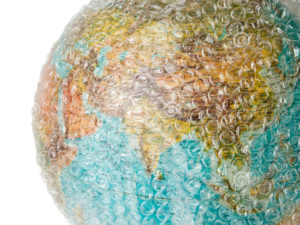Shipping ceramics is one of the biggest challenges to the ceramic studio artist. It is expensive, time-consuming and always a bit of a puzzle. Nowadays, it is an essential part of any active practice. To manage concerns about how your materials effect the environment can make shipping sustainably feel like a losing game. In line with the rest of this chapter, let’s work on getting informed.
*For tips on how to pack check out Chapter 8 : Shipping Work
Bubble Wrap and Polyethelene Products

Packing materials like bubble wrap made from polyethylene main drawbacks are that they are not biodegradable, taking up to 1000 years to breakdown. This has negative effects on land, water, air and ecosystem health. There is even research showing that marine life’s consumption of plastics has been making its way back into our own bodies with tiny particles of plastic found in fish and shellfish that we consume. Considering the mass quantity of plastics being produced, and that only about 10 percent gets recycled, anything you can do in your daily life or artistic practice to reduce the amount of plastic put into the environment is important.
Alternatives to stay away from: Oxo-degradable bubble wrap is marketed as a green alternative to bubble wrap. However, the chemical additives which promote the breakdown of the plastic only turn the plastic into tiny microplastic particles. This may be worse than plastic which stays together and can be kept separated from the soil or water.
Alternatives to Bubble Wrap: One of the upsides to bubble wrap is that it is lightweight which helps reduce emissions in the vehicles that transport your shipments. So the ideal alternative to bubble wrap should be lightweight, biodegradable or compostable.
- Corrugated paper rolls
- Cellulose Wadding – multilayered textured paper
- Packing Paper
- Cardboard
Check Out Ayumi Horie’s video “7 steps to packing with cardboard”
Styrofoam
Expanded polystyrene foam (EPS) is what makes up the styrofoam that we use in the form of peanuts and sheets for packing. However, it is estimated that it takes roughly 500 years to breakdown and accounts for 30 percent of landfill contents. Similar to other plastics, when it makes its way into the ocean, marine life suffers. What can we use in its place?
Alternatives to Packing Peanuts
- Biodegradable peanuts- these are a good alternative although they give way to pressure which means that they are much more crushable than regular peanuts. Some people use a 50/50 mix of regular peanuts and eco-friendly peanuts.
- Vermiculite
- Crinkle-Cut Paper
- Packing paper
Waste
In most cases, after your package has arrived safely, you can and should assume that all of those materials will likely go into the garbage. Most ‘normal’ folks are not like artists who hoard peanuts and bubble wrap like the precious resource it is. This is another layer of packing and shipping to carefully consider. However, perhaps a silver lining might be that when getting ceramic objects into people’s homes we are offsetting some of the consumer throw-away cultures.
Article By Aaron Nelson from “Sustainable Ceramics” by Robert Harrison
“If you amortise the energy required to fire the cup over the average lifespan of its useful life of an average of 50 years it takes about 13 watts per year, about what a standard compact fluorescent bulb consumes in one hour. Aaron’s research has convinced him that the act of turning clay into ceramics can be incredibly efficient and consumes relatively little energy.”